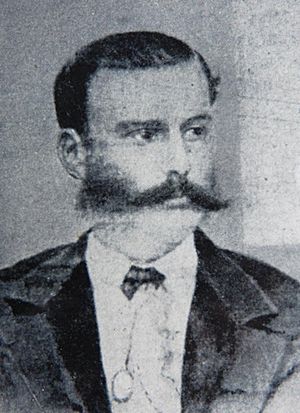Samuel Cocking facts for kids
Samuel Cocking (born March 19, 1845, in London, England – died February 26, 1914, in Yokohama, Japan) was an important merchant. He moved to Yokohama, Japan in 1869. This was soon after Japan opened up to the world. Even though he was born in London, he grew up mostly in Melbourne, Australia. In Japan, he is famous for the large greenhouse (660 m2 (7,100 sq ft)) and beautiful gardens he built on the island of Enoshima. These gardens are still known by his name today.
Contents
Who Was Samuel Cocking?
Samuel Cocking arrived in Japan shortly after the country began trading with the outside world. This period is often called the "Opening of Japan." He quickly became a successful businessman.
His Life and Family
Samuel Cocking married Miyata Riki in 1872. They did not have their own children. However, they adopted Miyata Riki's niece after her mother passed away. This showed their kind nature.
It was unusual for foreigners in Japan at that time, but Cocking was buried in the Miyata family's Buddhist cemetery in Yokohama. Most foreigners were buried in a special cemetery for people from other countries. His younger sister, Florence, who also lived in Japan, was buried there.
His Business and Contributions
Samuel Cocking owned a company called "Cocking & Co." His company traded many different things. They specialized in buying and selling Japanese curios, art, and antiques. They also imported important items like chemicals, medicines, and scientific tools.
For example, he imported carbolic acid. This was a strong disinfectant used to clean things and stop the spread of sickness, especially during outbreaks of cholera. It is said that during one cholera outbreak, he gave away all his carbolic acid for free to help people. He also exported peppermint oil, which came from peppermint plants grown in Yamagata prefecture in Japan.
Samuel Cocking is also known for bringing new ideas and products to Japan. He helped introduce things like soap, bicycles, and even the electric lightbulb! He was very involved in the early days of photography in Japan. He imported photographic materials and chemicals. He also helped start the first photography club in Japan. He even helped create a photography store called Konishi Honten, which later became the famous company Konica.
The Enoshima Garden
In 1880, Samuel Cocking bought land on the island of Enoshima. He bought it in his wife's name. This land included highlands and old, unused Buddhist shrines. At that time, the new Japanese government had a policy called Haibutsu kishaku. This policy encouraged people to move away from Buddhism. Because of this, the land became available.
Cocking began building his amazing botanical gardens and a large house on this land. He wanted to create a beautiful place with many different plants.
A Special Offer: The Daibutsu
During the time when anti-Buddhist feelings were strong in Japan, Cocking was very active in the trade of Japanese curios. One famous story tells that he was offered the Kamakura Daibutsu (a giant Buddha statue) for a very low price. However, he refused to buy it. He likely felt that the statue was too important to Japan's culture and should stay in the country.
The Garden Today
In 1887, Cocking added a power plant to his property. This power plant later became the start of the Yokohama Cooperative Electric Light Company.
Today, his garden is managed by the city of Fujisawa. It is now called the Samuel Cocking Garden. This name was given to it after parts of Cocking's original greenhouse were found during work on the lighthouse and gardens. It remains a popular and beautiful place to visit.


